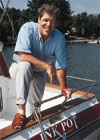 |
|
|
  |
 |
 |
 |
It alarms me how obtuse I can be sometimeshow, for instance, I can look out the kitchen window and see a dozen black vultures perched in the hickory tree and not instantly suspect that theres something dead or dying out there. They were vultures, after all, a dozen harbingers of death right there in front of me. It couldnt have been more obvious if one of them had knocked on the door and said, Hi, Im a vulture. I was wondering if youd mind if my friends and I held a little death vigil over there in the hickory tree. Well keep the noise downjust the occasional internecine hissing as we fight over rotting flesh, and of course that ominous whooshing-buzzing sound that our wings make.
To anyone else it mightve been that obvious, but my mental gears were slipping that morning. All I thought was, Hmmm, thats strange; what are all those vultures doing in my tree? I wonder if theyre migrating or something. That, more or less, is what I said to the person who was on the other end of the phone at the moment. And she, gears fully engaged, said, Maybe one of your cats is taking a nap under the tree. Mm-hmm, I said. Then . . . Oh! . . . yes, Ill bet theres something dead out there. She could have said, Of course, you bonehead. But shes a kind person; she said, Most likely.
And so it was that I ventured into the meadow in search of a carcass. The first thing that caught my eye as I scanned the ground was the life-size plastic target deer that my neighbor J.C., a bow hunter, sets up in the meadow every fall. Could that be it? Could the vultures think it was . . . no, of course not. Theyre professionals; they know a plastic deer when they see oneunlike some humans, who, after all these years, still flinch when the damn thing looms in the headlights. There were easily three dozen vultures, I realized, as I walked into the meadow. One after the other, they grudgingly abandoned the hickory tree, and several other trees at the edge of the woodsand, more tellingly, the banks of the cove on the opposite side of the meadow. A lot of them came from there, turning my suspicion in that direction.
Thats where I found it, the object of the scavengers fascination: a six-point buck lying on its side in the cove, about eight feet from the bank, all but submerged in the clear, shallow water. He was a forlorn thing to look at, with his face and wide-open eyes perfectly visible beneath the glassy surface. His left antler jutted from the water like a piece of driftwood, and the thickest part of his torso made an oblong, fuzzy island. Im not sure why, but my first instinct was to shoo the few brazen vultures still lurking in the trees. I feinted toward them and shoutedit was more of a bark, actuallyuntil they got the message and flapped calmly and heavily away. Then I stood at the bank and stared at the deer for a solid 10 minutes, wondering what had brought him to this undignified end, and wondering if there was anything I should do.
No, I decided, he belonged to the vultures nowor perhaps to the crabs, if the tide and current should carry him into deeper water. I had no role in this drama. I should not interfere; I should keep my distance and observe. However obtusely.
![]()
Tim Sayles, Editor
